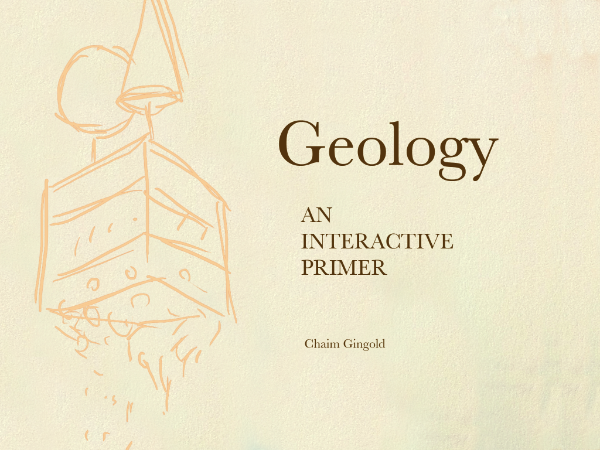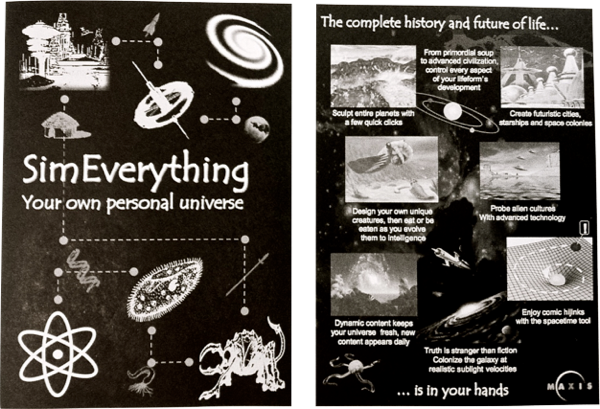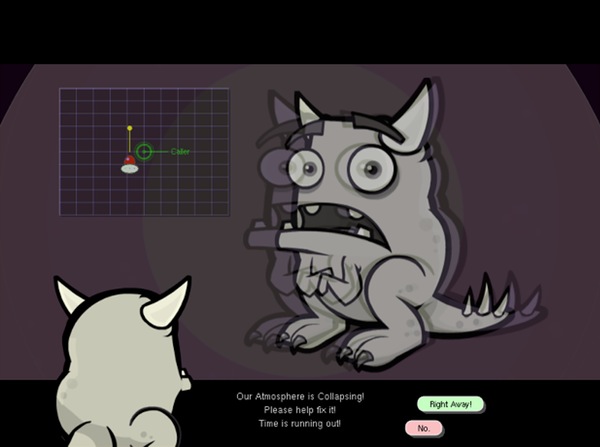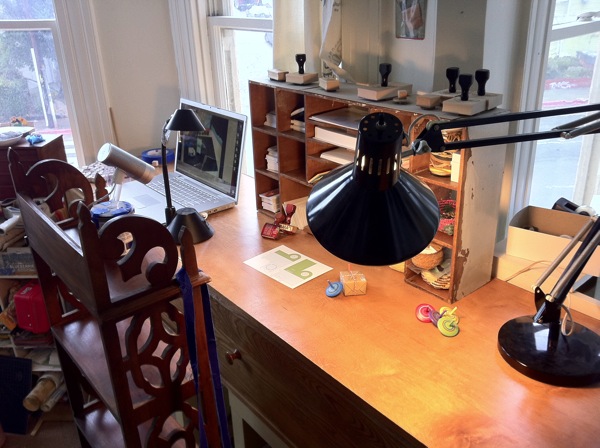I have an new portfolio site! It’s much more up to date than this little old blog, and has cool new projects on it. Check it out:
🌻🌻🌻
http://chaim.io
levity, design, & play
I have an new portfolio site! It’s much more up to date than this little old blog, and has cool new projects on it. Check it out:
So Earth Primer, which used to be “GeoBook,” is nearing completion! It’s been a long journey. I won’t say much about it here because I’ve been working very hard on a web page and trailer (www.earthprimer.com). It should be coming out very soon, within the next month or so. As soon as the launch date is fixed I’ll post an update.
[Update: Earth Primer is out. App Store link.]

Last year Lea Redmond and I co-designed a game/installation called Toy Chest for the SF Come Out and Play Festival. Originally we called the game Toy Fight, but found that this wasn’t putting people in an appropriately cooperative/improvisational frame of mind. The basic idea was to design a game (and installation for the exhibit) which would allow players to bring any toy they wanted to a playful contest.
The whimsical absurdity of Optimus Prime going head to head with My Little Pony motivated us, as did finding new ways to play with old toys, and meditating upon material culture. It was also a fun excuse to collaborate, since Chaim mostly makes screen based works, and Lea’s creations tend to be physical three dimensional things.
I just finished teaching a class at Univ. of California Santa Cruz on Simulation for Games. Below is a demo reel of the student projects. At the class page you can learn more about the class, play all the student projects (in browser!), and read the syllabus. Final projects are prototypes of dynamic explanations embedded in Wikipedia pages.
More at the Simulation for Games course web site.

I recently gave a talk at the ASAP/3 conference that sketched the history of computers as tools & playthings. I’ve learned my lesson on giving dominantly visual talks: if you don’t have good notes then they are a major bummer to give in the future, plus nobody else can read them. What was I thinking when I made a slide with two blue arrows on it? You’ll find that you can basically read my notes off each page of the pdf: it’s almost exactly what I say during the talk. You’ll have to imagine my voice though. Two video segments (one of John Cimino showing off the Spore Creature Creator, another of Steve Jobs discussing computers as bicycles for our minds) are missing, but otherwise it’s complete. From the talk:
If we look at the history of computation we find that Magic Crayons represent the intersection of two major historical threads, different ideas about what computation is for & how we should use it. One story is of how visionaries saw in the computer—in mechanized computation—the possibility of augmenting our ability to think & solve problems; the other is of computers as toys, devices for showing off the capabilities of these new machines, bringing them to the masses, and entertaining them.
The story I will tell you today is how these strands separate strands developed in parallel, and then intersected, giving us a new class of computer software that I call Magic Crayons.
Jan. 2015 update: see the launch trailer and learn more at EarthPrimer.com.
So, IndieCade happened, and we (we being my project & me, I suppose) were lucky enough to be selected for inclusion in the festival! I made two videos for the festival that I’d like to share. First, a trailer so you can finally see the book in action:
Second, an awkwardly candid video of me talking about the project:

Jan. 2015 update: See the launch trailer and learn more at EarthPrimer.com.
Last week I wrapped up my submission to IndieCade. It’s not actually a game—like much of the stuff I find fascinating these days—and this requires some explanation. IndieCade, you might be surprised to learn (I was), isn’t just for games. They want everything interactive, awesome, and independent.
The story of how I got here is kind of long and torturous, but I’ll give you the short version. I was working for a couple years on a project called Pocket Kingdom, that had a people simulator, world simulation, world editing tools, multiplayer—all kinds of ambitious zaniness, when I finally understood that despite having some awesome prototypes, was much more than a single indie developer could pull off. “This project looks amazing, but I want you to finish it while you’re still young,” was Rod Humble‘s response to a (hugely scoped) demo I gave to a San Francisco game design brain trust. What I had was something like 10 indie projects in one, and I started to calve off smaller projects from this bigger one.

This essay was written part way through Spore’s development, and summarizes one of the biggest transitions the project made — unknown to many — from what could have been a SimEarth like game/science toy to a capital-G computer Game. It tells how Spore made some of its early, and most crucial, navigational decisions down the branches of design possibility, to use Will’s own language. I feel like a discussion of how Spore turned out versus audience and developer expectations is a whole other story that should be distilled and told, but this is not the place for that.
Originally published in Third Person, edited by Pat Harrigan and Noah Wardrip-Fruin.
Spore grew from Will Wright’s fascination with the vastness of the universe, and the probability that it contains life. Wright linked Drake’s equation, which computes the probability of life occurring in the universe, with the long zoom of Eames’ Powers of Ten film. Each term in Drake’s equation corresponds to a different scale of the universe, and a different zoom of the Eames’ film. “Spore†stood for the spread of life through the universe: minute seeds of life hopping from one planet to another, either as bacteria riding comets, as panspermia theorizes, or intelligent beings on spaceships.
Early Spore prototypes and design concepts focused on simulating the movement and evolution of alien creatures, fluids, the birth of stars, galaxies, nebulae, and the spread of intelligent and non-intelligent life in media as small as a bread crumb, and as large as a galaxy. There was a galactic potter’s wheel, where you could try your hand at forming a stable spiral armed galaxy. A blind watchmaker interface allowed you to guide the evolution of novel life forms. You could sculpt huge piles of gas into stars that were just right for life. Will’s idea, at this point, was that players were to directly experience the difficulty and frustration of making life in the universe, and appreciate the improbability that life exists at all.
I initially joined the project at this early prototyping phase, when Spore was no more than a handful of people, and felt less like a game development project, and more of an awesome research and simulation endeavor. To me, the project was an intellectual love letter to all of existence, a depiction of the entire universe as a complex of interlocking self-similar systems. Patterns emerged ― everything, from disease to culture and space travel could be represented through some combination of cellular automata, agents, and networks. This was my summer dream job: make toys about anything in the universe, using everything I knew about interactive graphics and simulation, for the greatest simulation connoisseur in the world.
The following essay was originally published in Tracy Fullerton’s Game Design Workshop (2008). I had given talks in the past on prototyping, but this was the first essay I wrote on the topic, and I think it holds up. If you’re interested in the Advanced Prototyping talk Chris Hecker and I gave at GDC’06, check out the old site, and scroll down a bit.

My hard drive was full of failures. Twelve years after learning to program, I looked back on all my software: none of it was finished, and what was, wasn’t ambitious enough. The projects that started out ambitiously always seemed to fall back to earth, like failed rockets lacking the power to propel their own weight into orbit. Sure, there were interesting ideas in there, lots of wacky toys, and I had even attempted a few large projects, but none of them ever came together like the cool games and software I had always admired.
Sure, I had become a pretty good programmer, and learned to make cool stuff, but clearly none of it would ever amount to anything. I just didn’t have what it took.
I went to graduate school at Georgia Tech, and read some Chris Crawford. I learned that he had the same problem. But he didn’t think of it as failure. For him, this was an organic part of the development process. The failures filling his hard drive were actually “prototypes†that helped him decide which ideas were worth pursuing. For each good idea, there were a large number of stupid ones that didn’t work out. Failing, for this successful designer, was a way to find the good ideas. The revelation hit me like a ton of bricks. Maybe I had a chance after all.
Continue reading “Catastrophic Prototyping and Other Stories”
I recently helped my friend Lea Redmond over at Leafcutter Designs make a cute little stop motion animation for her World’s Tiniest Post Service.
I don’t think the promotion is still available, but the tiny letters and packages, not to mention many other goodies, are still available over at her site.
We began by making a test animation of a self-assembling mailbox, to get a feel for what was possible. For the final shoot, we used an ancient web cam, multiple lamps to control the lighting, and staged part of Lea’s studio as a backdrop. Below is an image of the final rig and stage we used for the animation. Making the animation was loads of fun!
